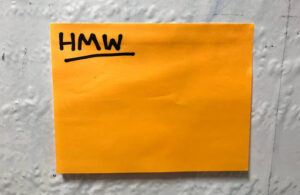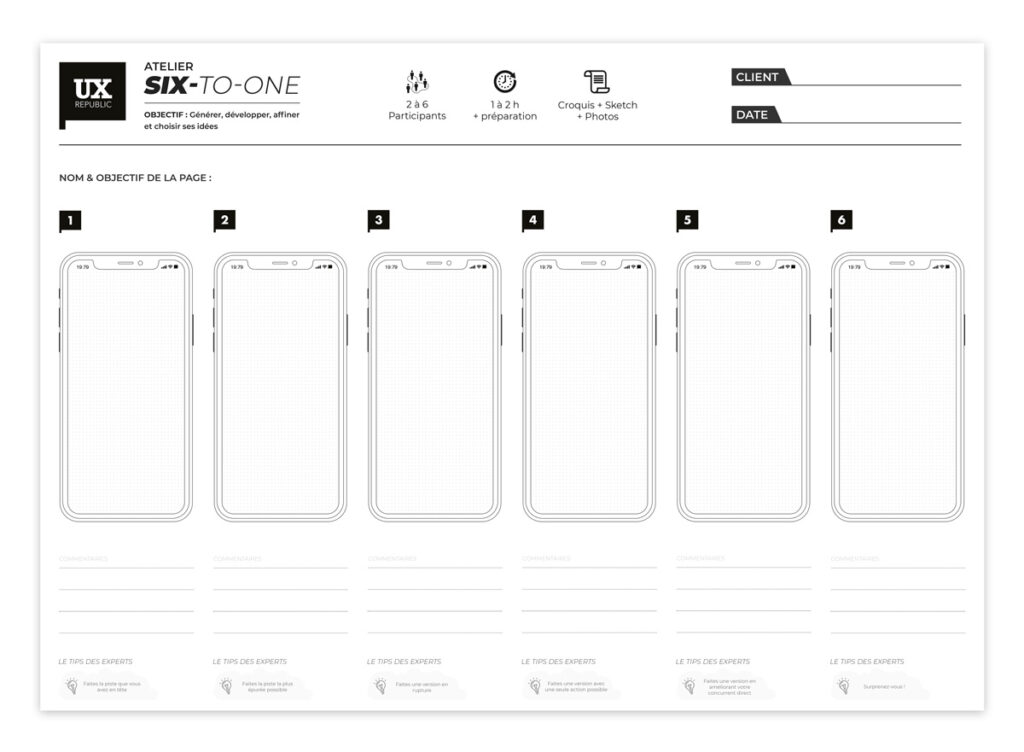
In the first part of this article devoted to the Design Sprint, I took stock of its origin, its reasons for being and its development, theoretical and practical. Its implementation on various occasions also brought me other lessons, which one does not usually read in the (short) articles devoted to this method, still far from being overused.
What it is not...
Obviously, this approach has its risks, because it can be misunderstood, or even misapplied. Indeed, on the one hand, a misunderstanding and a significant gap can emerge between the vocation of the sprint (see Part 1 of the article) and customer expectations. On the other hand, the sprint will run all the better if the person facilitating it has good experience in leading workshops in general, and this type of exercise in particular. Indeed, it is necessary to have both a certain distance in order to absorb the overflow of energy contained in the room and to keep a cool head for everyone, but also the firmness (always benevolent) to frame and reframe when it is 'is necessary.
In all cases :
- Le
 design sprint is everything except a magic solution to all your problems... but, as we have seen, rather a collective, active synergy, focusing on the development of a hypothetical solution to a particular problem, the famous MVP. It will therefore not be a question of testing and validating all the functional options or the possible paths to obtain a global solution. Typically the design sprint is not indicated for a redesign of a site or a business tool as a whole. Conversely, it can be useful for designing a "single-task" app, addressing a particular journey problem, testing or designing a feature... By definition, our solution will address the target and one of the problems mentioned at the start of the sprint, nothing else.
design sprint is everything except a magic solution to all your problems... but, as we have seen, rather a collective, active synergy, focusing on the development of a hypothetical solution to a particular problem, the famous MVP. It will therefore not be a question of testing and validating all the functional options or the possible paths to obtain a global solution. Typically the design sprint is not indicated for a redesign of a site or a business tool as a whole. Conversely, it can be useful for designing a "single-task" app, addressing a particular journey problem, testing or designing a feature... By definition, our solution will address the target and one of the problems mentioned at the start of the sprint, nothing else. - By extension, it will be even less the opportunity to review the strategy or the image of an organization / company hoping to review everything in 5 days.
- The sprint is not an end in itself. In other words, if it makes it possible to test a solution, it will rarely be mature enough or complete enough to be implemented immediately. It will certainly require adjustments, improvements, even more tests, in short, iterations before it goes into production, with its own delivery-ready files upstream (which the sprint prototype is not supposed to be).
- It's not a hackathon either. where we will look at several solutions at the same time. As we have shown, it is necessary in the middle of the course to converge towards a solution (whether it is a course or a screen). This is not AB(CDEF…) testing. The sprint must carry its own value proposition.

In short, it do not confuse Design Sprint with sprint, in other words speed and haste. The sprint cannot address all the issues at the same time, misused or by not respecting at least its format, its stages and its goal, it could prove to be counter-productive or even destructive because it is exhausting and deceptive.
Sprint out of the book
If the sprint is ideal for “thinking outside the box” (think out of the box), it is also sometimes necessary to put the book down and not following all its precepts to the letter, at the risk of remaining blocked either in the face of an insoluble problem or in a particular situation at a given moment.
The person leading the sprint should use common sense and more or less flexibility, pragmatism in any case, to bring it to an end, if not its goal. If she is the guarantor of time and successive stages, she will often have to adapt her game because she is faced with other humans. Benevolence must sometimes take precedence over the “time timer” and it happens that we overflow the allocated time. It will also be necessary to know how to manage the susceptibilities or shyness of some, to temper others. But also adapt to the constraints of the participants (room exits for an important phone call, untimely disappearance/reappearance, when on the client's premises). The patience of the facilitator is therefore often put to the test. Hence the concept ofexperience, more to be able to have the necessary perspective and affirmation, than to be able to roll out the method rigorously by heart as we have done it in the past. It will therefore be necessary to find a certain balance between all these data, because the main thing is that the customer is satisfied, and that we "sort" a solution, without it costing anyone's life.

Fact, we can very well animate a sprint for two. Indeed, as in a couple one takes over to take care of the child because the other is momentarily exhausted, in a sprint situation it can be quite significant to be able to rely on an alter ego. in the face of recalcitrant or “too” full of energy participants. Or to make sure of a choice or an orientation.
I also realized that all the steps are not blocking if they are not carried out. For example, going directly to sketches that are a little advanced without going through the Crazy8, which is a rather destabilizing exercise (and it must be said that it is more suitable for designers), is quite possible, especially if you have fallen behind in the previous step. Because yes, sometimes you have to manage a bit of elasticity over time and forget the “timer” if a step is not considered to be advanced enough. The important thing is to finish the prototype on Thursday and to have organized the tests on Friday, because it does not matter if everything is not perfect, the important thing is to collect the maximum user feedback (feedback).
 Another exercise that does not always convince me: the so-called note-taking technique “How Might We” (We write HMW at the top left of the post-its, and we write in the form of questions or opportunities the problems raised during the Monday interviews with the experts). First, the instruction is not always well understood and the result may look like a collection of keywords or long comments. Then, it corresponds rather to an Anglo-Saxon turn of mind. Indeed, the French, who are usually critical and Cartesian, have perhaps more difficulty projecting themselves towards an interpretation and a relatively open and positive perspective. Besides, we could transform “How Might We” into “How To Fail”, an alternative exercise consisting of identifying the reasons why the project could fail in order to find the solutions that will guarantee its success.
Another exercise that does not always convince me: the so-called note-taking technique “How Might We” (We write HMW at the top left of the post-its, and we write in the form of questions or opportunities the problems raised during the Monday interviews with the experts). First, the instruction is not always well understood and the result may look like a collection of keywords or long comments. Then, it corresponds rather to an Anglo-Saxon turn of mind. Indeed, the French, who are usually critical and Cartesian, have perhaps more difficulty projecting themselves towards an interpretation and a relatively open and positive perspective. Besides, we could transform “How Might We” into “How To Fail”, an alternative exercise consisting of identifying the reasons why the project could fail in order to find the solutions that will guarantee its success.
We could very well also imagine integrating other workshops, more suitable and which could serve the sprint, as long as we keep the sequential aspect, essential to its smooth running (eg: proposing one or two 6to1 - read our article – during the sketch day).
You can also advance or skip certain phases. For example, if the sprint is progressing well and if everyone shares the same vision, it is not mandatory to proceed with all the inter-workshop votes, a vote at the end of the day may be sufficient. Similarly, the decision-maker does not always want to use his supervote, why force him to?
In short, once again knowing how to get out of the nails is not forbidden, even if we imagine that J. Knapp may have already tried everything, it is important to continue experimenting while seeking to satisfy the client and his project, taking the sprint as a framework and not as a table of commands and partially including, from time to time, typical UX methods.
The Design sprint within the UX Republic approach
As we said above, the design sprint is not enough on its own. From the outset, it seems absolutely necessary to us to "supervise" it and to plan at least a phase ofupstream immersion (see our offer), if the client has solid elements to feed the sprint, or even to plan a research and/or audit phase if necessary. It's neither comfortable nor very effective to start a sprint from scratch, without having learned a minimum of information about him, his sector, his competitors and above all the understanding of his profession and for what concerns us in first, its users.
Then, at its end, the sprint will certainly still require a few iterations to improve the solution so that it meets user needs as closely as possible, its market, its environment. It can also be the basis for future complementary work. It is moreover somewhat its latent vocation, since it is geared towards innovation: to be the starting point of the next future of the sponsoring organization. We therefore recommend a follow-up to the sprint in order to be able to finalize the concept and put it into production properly, and why not in the long term to engage in collaboration with a view tosupporting our client in its transformation.
Alexis CANGY | UX/UI consultant | Design Sprint Master
